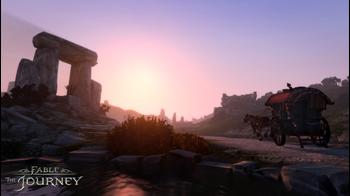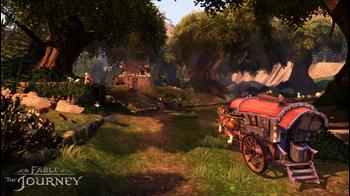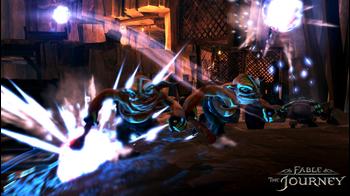
Fable: The Journey Review
"It's not on rails!" How we remember those words, and being ushered to the wall of Microsoft's E3 booth to sign to attest that, according to what we'd been told by Peter Molyneux, we understood Fable: The Journey wasn't. It was a bizarre moment, a personal highlight of the show - but what playing the final version of the game has shown me is that the rails don't really matter.
We may as well start by addressing that particular claim now it's reached internet meme status. Fable: The Journey essentially is on rails. There's a degree of freedom to movement, but the story continues on a linear path that is more akin to an open-ended light gun shooter than the previous Fable adventures.
The game sees you riding a horse through Albion, and while you're on a set path there is a sense of scale and drama to the story that betters Fable III. It's the largest version of Albion Lionhead has ever constructed, but it's easy to see why - it's a set path, winding through a plethora of different environments, the titular journey punctuated with combat.
The choice of the horse and cart is an obvious and wise one for Kinect. This allows the player to sit, both hands raised as if you're holding the reins.
A tilt or a twist will steer the horse and cart through Albion, while flicking the reins will cause your horse, Seren, to increase her trot.
As with Kinect Joy Ride there's a degree of auto correct on your movement as you drive the horse, so it'll mostly point you down the correct path of its own will, though you're free to break away somewhat. When the path does branch for optional areas, it's quick to rejoin the default path again.
These sequences are less about gameplay and more about relaxing and enjoying some downtime between combat, laying the groundwork for the story with dialogue between hero Gabriel, Fable series regular Theresa and a selection of temporary passengers who hop on your cart for a ride.
In this it's successful - the first Fable game to feature fully fleshed-out cutscenes that appear to have been motion-captured, Fable: The Journey presents the most interesting and real feeling cast the series has managed to date - including a named protagonist with a personality for the first time. The world of Albion feels more real thanks to these characters, and the apocalyptic threat on display helps to paper over some of Fable III's narrative cracks and set up hooks for a fourth proper Fable game in equal measure.
It's a great story, and one that's made better by the time spent rolling slowly through the countryside scenery. There's a constant sense of urgency in this game, but it also has a leisurely pace that allows you to drink in and begin to care about the world and its characters. One or two moments are incredibly memorable and moving, especially considering how much time Fable spends joking about.
It wouldn't be a Fable game without a morality system, and that's true here - your horse is a cipher through which the player can channel their morality - you can look after and tend to it lovingly or treat it as a mere tool for getting across Albion.
The choice is yours, though as with Fable II's dog the game does a pretty good job of instilling a sense of wanting to care about Seren. The third pillar of the game after combat and travelling is camp, and in these sections you tend to Seren and gain experience through it, which can then be spent on more spells. Looking after Seren rewards in gameplay, then, but also just feels like the right thing to do.
All of Albion looks great and has survived the switch from an in-house engine to Unreal well. Fable: The Journey gives off the impression that it's often pushing less graphical power than it could - presumably due to Kinect needing additional processing power - but as Albion whizzes by it looks fantastic.
The combat is where the rails are really exposed - here it's a light gun style game where Gabriel hops out of his cart to march on a predetermined path, your hands and magic replacing a plastic gun and bullets. I'm a fan of the light gun genre, and the core idea behind this is actually all pretty cool.
There's a number of spells and Fable's RPG roots are retained through basic character progression, upgrades purchased with experience.
There's depth in mixing and matching the various spells to achieve often vastly different effects. A variety of enemies appear to encourage different approaches to situations too, with some enemies requiring specific methods of attack.
It's a simple system to grasp with a decent amount of depth and in the right moment and when spells come out correctly you can find yourself having real punch-the-air moments of awesome spell-juggling, sending enemies flying.
The problem lies in the fact that you can't punch the air because if you do Kinect will go completely - excuse the pun - off the rails.
Lionhead clearly understood Kinect's limitations are the movements to cast the game's various spells never require much finesse - they're wide, massive movements - but Kinect still manages to lose control far too often to be acceptable.
It's not unusual to be part-way through an incredible combo of magic spells only for one to inexplicably fly towards the ground or off into the sky, while the simple gesture to block often seemed to have a lag on it that meant I was all too often failing to parry moves. Experimenting with my setup helped a great deal, but things were still going wrong way too often.
Beneath this layer of unacceptably hit-and-miss control, a great game lays waiting to burst out. It looks nice, has a heartfelt story and interesting, simple gameplay mechanics with decent depth... but all that is worth nothing when the Kinect hardware and software fails to register the gestures that are vital to control it.
With this we come full circle. What Fable: The Journey has taught me is that it doesn't matter if the game is on rails or not - if its controls are broken, the game is broken. When it works it's magical, but it doesn't work often enough. With the potential the rest of the package has, that is a crying shame.


